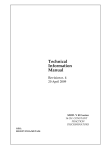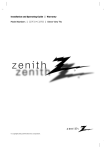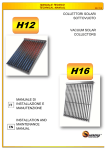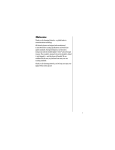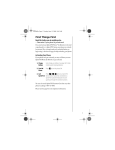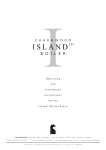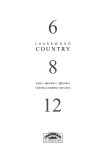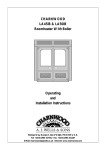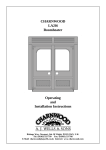Download Charnwood OLX Operating instructions
Transcript
CHARNWOOD OLX Oil Fired Hearth Boiler Operating and Installation Instructions Bishops Way, Newport, Isle of Wight, PO30 5WS Tel: +44 (0)1983 537799 Fax: +44(0)1983 537788 E-Mail: [email protected] Internet: www.charnwood.com CHARNWOOD OLX45 Operating and Installation Instructions Operating Instructions General Points ........................................................4 Fuel..........................................................................4 Controlling The Boiler ............................................4 Electric Flame Effect and Fan Heater ......................4 If The Burner Fails to Light......................................4 Maintenance............................................................4 Replacing the Flame Effect Bulb...............................4 Installation Instructions Health & Safety Precautions....................................6 Standards & Regulations..........................................6 Performance...........................................................6 Air Supply...............................................................6 Chimney..................................................................6 Hearth & Fire Surround..........................................8 Oil Supply................................................................8 Preparation of the Fireplace....................................9 Central Heating System...........................................9 Fitting The Fire.......................................................10 Electrical Connection..............................................10 Combustion Chamber Assembly............................10 Finishing The Installation.........................................11 Commissioning.......................................................12 Overall Dimensions................................................12 Specifications..........................................................14 Wiring Diagram......................................................15 Electrode Settings...................................................16 Exploded Parts Drawing - Boiler.............................17 Exploded Parts Drawing - Burner...........................18 Bishops Way, Newport, Isle of Wight, PO30 5WS Technical Support Tel: +44 (0)1983 537799 Fax: +44(0)1983 537788 E-Mail: [email protected] Internet: www.charnwood.com Page 3 OLX V5.2 05.04 Charnwood OLX Oil Fired Hearth Boiler Operating Instructions GENERAL POINTS Before using the boiler for the first time, check with the installer that it has been correctly installed and commissioned. Do not attempt to use the boiler before it has been commissioned. FUEL The boiler is set up to burn 28 sec. viscosity oil, this is commonly known as Kerosene. Do not use Gas Oil. Burner Reset Button Located Through Hole In Front Panel CONTROLLING THE BOILER The boiler is controlled by the thermostat which is on the left hand side of the fire, it is the lower of the two control knobs (see Fig. 1.) This sets the temperature that the boiler will operate at. A Central Heating Time Clock or Programmer will normally control the heating system. ELECTRIC FLAME EFFECT & FAN HEATER The electric flame effect operates completely independently from the boiler and is switched on and off by the top control knob on the left hand side of the fire (see Fig. 1.) Turn the knob to position "1" to operate the flame effect. The flame effect may take a few moments to become established when first switched on after long periods of not being used. Position "2" is used for the 1KW setting of the optional fan heater if fitted. Position “3” is the 2KW setting. If the room temperature becomes excessive, the internal thermostat will switch the heater to blow cool air until the temperature falls, when it will revert to its previous setting. Serial number Label Inner plate Bottom plate Fig 2. Burner Reset Button IF THE BURNER FAILS TO LIGHT If the burner fails to light then the Reset light on the Burner Reset Button may light up (see Fig. 2.) This situation is known as “Lockout” in which case wait for 1 minute and press the re-set button (located through the hole in the front panel behind the doors.) The burner will then try to ignite again. If the burner continually goes to lockout, then the cause needs to be established and the problem put right. The most common causes are lack of fuel, or air in the fuel line. Check that the oil tank is not empty, and that all valves are open. The troubleshooting guide gives further steps, some of which will require action by a trained Oil Engineer. Do not press the reset button more than five times in a row as this can cause damage to the pump. MAINTENANCE Flame Effect and Optional Fan Heater Control It is important to have the appliance serviced each year. Please arrange this with an OFTEC approved Heating engineer. The flexible oil supply hose must be replaced every 2 years Replacing The Flame Effect Bulb Boiler Thermostat Turn Handle Clockwise To Open Fig. 1. Controls Replacing the bulb in the flame effect is a simple operation that can be carried out without using any tools. Ensure that the flame effect is switched off before attempting to replace the bulb. Open the doors and Page 4 OLX V5.2 05.04 remove the coals. Lift off the Front Fence. Lift out the fibreglass coal effect. Lift the right- hand end of the bulb and cover out of its clip, see Fig. 3, then unplug the bulb, moving it towards the right. Slide the cover off and discard the old bulb. Slide the old cover onto the new bulb and insert the bulb base into the holder on the left. Ensure that the bulb is pushed fully home, then lower the right-hand end and press it into the clip. Replace the fibreglass coal effect, with the rear edge passing just under the Perspex. Re-fit the front fence and replace the coals. Sleeve Holder Clip 1) Lift Bulb from clip Sleeve Bulb 2) Remove Bulb from Holder Fig. 3. Flame Effect Bulb Replacement Page 5 OLX V5.2 05.04 Charnwood OLX Oil Fired Hearth Boiler Installation Instructions HEALTH AND SAFETY PRECAUTIONS Please take care when installing the appliance that the requirements of the Health and Safety at Work Act 1974 are met. Some types of fire cement are caustic and should not be allowed to come into contact with the skin. In case of contact wash with plenty of water. No asbestos is used in the appliance but if there is a possibility of disturbing any asbestos in the course of installation then appropriate protective equipment must be used. When handling insulating materials a suitable face mask and protective gloves should be worn. Take care when handling fuel oil which can cause skin irritation, avoid contact with the skin or clothing, take care to wash hands well after contact with fuel oil and before eating. Fuel oil must never be taken internally. STANDARDS & REGULATIONS In addition to these instructions the requirements of the following standards must be fulfilled: BS 5410 Pt 1 Oil Installations Under 45 kW BS 5449 Forced Circulation hot water central heatingsystems for domestic premises BS 7671 Electrical Wiring Regulations boiler and a ducted air supply must be provided to the right hand side of the boiler at this point. A two metre length of flexible ducting and fixing clips are supplied with the appliance to connect the air input from the appliance silencer to the rigid plastic ducting. The air pipe should be sealed into the appliance using a silicone sealant. The ducting should be run in 50 mm dia. (2") plastic pipe and must terminate in free air - preferably either outside or in a ventilated loft space. The end of the ducting must be fitted with a suitable cage to prevent entry by birds or small mammals. The ducting should be boxed in where it passes through living areas. The length of ducting should be kept to a minimum, and the maximum recommended length is 10 metres incorporating up to 4 bends. (One bend is approx. equivalent to 1 metre of straight pipe). Provided that the ducting terminates as described above there is no requirement for a separate combustion air supply in the room in which the appliance is installed. However, if the ducting terminates within a living space then there must be an adequate air supply into that room totalling at least 55 sq. cm. (8.5 sq. inches) to provide combustion air. CHIMNEY The chimney should comply with BS5410: Part 1 and must meet Building Regulations. Local Authority Bylaws and Building Regulations regarding the installation of Oil Burning Appliances, flues and chimneys and The Control of Pollution (Oil) Regulations must also be observed. The diameter of the chimney must not be less than 100 mm (4”) internal diameter. Oil boilers should be installed in accordance with good practice as recommended by OFTEC (The Oil Firing Technical Association for the Petroleum Industry, Banstead, Surrey. Tel: 01737 373311.) PERFORMANCE The output of the boiler is adjustable between 11-13 kW(38-44,000 Btu/h), a small amount of heat will be given out to the room but for purposes of sizing the system this should be ignored. The optional Fan Heater provides up to 2KW of heat to the room. AIR SUPPLY The air supply for combustion is taken from within the builders opening on the right-hand side of the As the boiler operates at high efficiency, it is important that the chimney is well insulated in order to prevent condensation forming. Brick or stone chimneys should be lined with a suitable liner. If a stainless steel liner is used in a brick or stone chimney then it must be insulated between the liner and the brickwork in order to prevent condensation that can reduce the life of both the liner and the boiler. Pumice liners will give the required level of insulation. As the flue outlet temperature is below 250°C stainless steel flexible flue liners suitable for oil may be fitted directly onto the appliance, although in the interests of reducing flue noise it is preferable to use a 600 mm length of rigid flue pipe from the appliance to the liner. Page 6 OLX V5.2 05.04 Page 7 OLX V5.2 05.04 If flue pipe is used to connect the appliance to the chimney it must be between 100 & 125 mm (4-5") internal diameter. The chimney termination must not be subjected to down draughts. If necessary an anti-down draught cowl may be fitted. The required draw for this appliance is 0.17 mbar (0.07 in H2O). HEARTH AND FIRE SURROUND The boiler waterways totally enclose the combustion chamber. This means that the maximum temperature below the boiler is 100°C and therefore a constructional hearth is not required. The hearth and base within the fireplace opening must be made from non-combustible material and must be flat and level. The hearth must be flat to allow easy fitting of parts on the fire. When positioning the boiler ensure that the side flanges on the boiler come level with the face of the fire surround. The fire surround should be made from non combustible material and have opening dimensions shown in Fig. 7 . per 1m of length downwards from the oil outlet to the sludge cock fitted at the opposite end. Plastic tanks should be UV stabilised for protection from sunlight. They do not need to stand on piers but should be supported across the entire base. Refer to the manufacturers instructions for full details. Be aware of pollution prevention regulations and the need for bunding if the tank is close to water courses or drains. In order to ensure quietness of operation of the Charnwood OLX a single pipe system is used. The oil storage tank should ideally be positioned with the base of the tank higher than the base of the fire. When the storage tank is below the level of the burner then an oil lifter must be used. An oil shut off valve is supplied with the boiler to allow the burner to be easily disconnected and minimise oil spillage. An oil filter should also be fitted outside the building, adjacent to the oil tank. A protective fire valve must be fitted in the oil supply line. The phial sensor should be mounted in the burner chamber The fire valve should have a cut out temperature of 90°C. Soldered joints are not permitted in the oil supply line, and all connections must be properly sealed to prevent oil leakage and air ingress. OIL SUPPLY The Charnwood Oil Boiler is set up to burn Kerosene 28 second viscosity oil to BS2869 Part 2 1988 Class C2. It comes complete with a flexible oil line and shut off valve, to which the oil supply line should be connected. Some schematic layouts of oil supply systems are shown in Figs. 4 & 5. When considering where to site the oil storage tank, consideration should be given to the access required by fuel delivery lorries. Tank positioning must also be in accordance with BS5410 Part 1 and OFTEC Technical Book 3. Oil tanks should have the following items: A valve fitted to the outlet Sludge valve (on steel tanks) Oil level indicator Hinged fill and vent cover or separate fill connection and vent. The fill and vent must be either suitably capped or have a return bend to keep out dirt and water. The oil supply line should enter the appliance from the left-hand side behind the side panel. The fitting supplied with the fire facilitates this. If the supply line is to run in front of the fireplace surround then it will be necessary to cut a section from the end of the bottom plate on the fire to give access for the pipe. It is preferable to bring the supply in from behind the fire surround. The oil supply line may be in either 8 or 10 mm dia. copper, dependant on the length of the run, however, the connection on the appliance is a 10 mm compression fitting. Steel tanks should be mounted on suitable supports. If they are mounted on blocks or bricks then a damp proof membrane should be fitted between the supports and the tank. Steel tanks should slope 20 mm The supply line MUST be flushed out in the following manner:Connect the supply line to the compression fitting on the service valve at the left hand side of the appliance, but disconnect the flexible hose from the other side of the service valve, and replace it with Page 8 OLX V5.2 05.04 the push on piece of 12 mm bleed tube supplied. Place the other end of the bleed tube into a suitable receptacle, and flush out the supply line by turning on the service valve. When the oil is clean, turn off the service valve, remove the bleed tube, and reattach the flexible tube from the burner. Turn the service valve back on, check for leaks, and clean up any spilt oil. Vermiculite infill 100mm id single skin flexible flue pipe around Flexible Liner Fire s u rround with removable metal closure panels PREPARATION OF FIREPLACE When replacing an existing boiler, remove any fireback and infill material to expose the builders opening. The opening must be at least 400 mm deep (when measured from the front face of the surround,) 600 mm wide (to give access to the boiler connections,) and 650 mm high (to give access to the flue connection. Ensure that the base of the fireplace is level with the hearth and that the face of the surround is vertical. It is necessary to have a small cut out in the fireplace surround at the bottom left of the opening in order to bring the oil and electrical supply to the fire. It is also necessary to have a small cut out at the bottom right of the opening to clear the air inlet duct. See fig. 7. Rockwool infill around flexible liner above closure High Temperature Silicone sealant. Closure Plate Appliance Connector Rockwool insulation around Appliance Flue fixing brackets Joint caulked with glass fibre rope and sealed with high temperature silicone sealant. Fig. 6. Typical Instalation using flexible flue liner right down to Appliance. The shaded area on the face of the surround is the minimumflat area required. 670 mm 770 mm CENTRAL HEATING SYSTEM 50mm 65mm 50mm The central heating system must comply with BS 5449, and should be installed in accordance with the current good practise guidelines as advised by the HVCA. Central heating design is a large subject which it is not possible to deal with adequately in this manual. The points that are particularly relevant to this boiler are dealt with below. Max. 470mm (18 1/2") Min. 405mm (16") Dim. B: Max. 579mm (22 3/4") Min. 555mm (21 3/4") Fig. 7 Limiting Dimensions Of Surround and Opening The heating and hot water system should normally be fully pumped, although a gravity hot water system may be used if it already exists. There are no internal divisions in the boiler, and any combination of flow and return tappings may be used. If it is possible then diagonal pairs of tappings should be used, but pairs on the same side may be used if required. The maximum working pressure of the boiler must not exceed 3 Bar ( 44 psi or a static head of 30m) In order to prevent a build up of scale and corrosion a suitable inhibitor should be added to the system. When replacing an existing boiler the system should 110mm Dim. A: be thoroughly cleaned before connecting the new boiler. Fully automatic central heating controls may be used to give full control of the heating and hot water. When designing the control system it is important to note that if the situation can arise where the flow of water through the boiler is stopped, or substantially reduced, whilst the burner is still firing, then this can result in the water in the boiler reaching very high temperatures, or even boiling, before the boiler thermostat can sense it and switch the burner off. If this is a possibility then Page 9 OLX V5.2 05.04 wire the controls to the burner so that it is switched off at the same time as the pump or motorised valves. This usually means wiring the supply to the burner into the output from the central heating programmer. Reset Button Oil Pressure Gauge Port Position the fire so that the rear face of the side flanges comes flush or very slightly in front of the face of the fire surround. Make the flue connection to the appliance, ensuring that the flue pipe is well sealed to the boiler, and fixed securely using the fixing screws and brackets, see Fig. 10. Connect the heating system to the boiler ensuring that the system vents correctly. Fill the system with water and check for leaks. Air Control 1-10 Ignition Unit (Behind Control Unit) Air Inlet Manifold Burner Control Unit FITTING THE FIRE Unpack the stove and remove it from its wooden pallet.. If a flue liner is to be used then this should be fitted in the chimney before fitting the fire. The liner will normally come down to a fixing plate and a short length of 316 Stainless steel flue pipe is then used to connect the boiler to the liner. Alternatively the liner may be fitted directly to the boiler, in this case ensure that the liner is adequately supported and that it will not vibrate when the appliance is in use. Use the Flue Fixing brackets and self tapping screws supplied to fix the flue securely to the boiler (see Fig. 12.) Mineral fibre or fibreglass should be used to reduce vibrations and insulate the boiler and flue. The space between the flexible liner and the chimney should be filled with loose vermiculite infill retained by a suitable plate in the chimney above the boiler to allow future access to the boiler without removing the infill (see Fig. 6). A suitable rain cap should be fitted to the top of the chimney. Photocell Oil Pump Nozzle Cover Plate Fuel Solenoid valve Air Pressure Switch Fig. 8. Oil Burner Assembly Shown Removed from Boiler. baffles fitted, and it is recommended that these be checked for position before initial firing. If it becomes necessary to re-fit the baffles and bricks, follow this procedure:Isolate from the mains supply, open the doors and lift up and remove the bottom plate. See Fig 2. Lift off the fence and the coal effect. Loosen the fixing screw at each side of the inner plate , slide outwards into the slot, and lift off the inner bottom plate. Lift the Perspex panel out of the fire and undo the two wing nuts on the back panel. Unplug the mains cable from the bottom of the flame effect. The flame effect may then be lifted clear. The boiler access door is now visible, and is removed by undoing the 4 brass nuts with a 10 mm socket. Take the items 1-5 in order and lower them into position in the bottom of the combustion chamber. Assemble them together in this position so that both side boards are tight in against the top & back boards, and the front face of the top board is hard up against ELECTRICAL CONNECTION The boiler comes pre-wired with two lengths of 3-core cable. The black cable is for the oil burner, the white is for the flame effect and optional fan heater. Connect the black cable to the output from the central heating programmer, ensuring that the supply is via a 3 amp fused switched spur. Connect the white cable to a separate 3 amp fused switched spur. If a fan heater is fitted, this fuse must be 10 amp. Ensure that the earth connections are made. Bleed Screw COMBUSTION CHAMBER ASSEMBLY Bleed Hose Connection Point The boiler comes with the internal insulation bricks and Page 10 OLX V5.2 05.04 Oil Pressure Adjustment screw. Clockwise to Increase, Anti-Clockwise to Decrease. Fig. 9. Oil Pump Details Top Baffle Nibs at front Assembly Order: 1. Base (Fibre Wool) 2. Back 3. RH Side 4. LH Side 5. Top 45° Chamfer 5 3 45° Chamfer 2 45° Chamfer 4 1 Combustion Chamber Insulation Board Order of Assembly Note! Numbers etched on to baffles must be in correct orientation when assembled. Fig 10. Baffle Arrangement the inner front of the boiler. There should be a gap at the back of approx. 25 mm, and equal gaps at the sides. The bottom baffle (No. 1) is now carefully lowered into position, so that the guides on its underside hold the insulation panels in place. When assembled the No 1 should be clearly visible, the right way up. The remaining baffles (Nos. 2-4 ) are assembled in order, with the numbers facing the front of the stove as shown in Fig 10. The access door is now re-fitted. Ensure that the rubber seal is pushed fully home to the frame, and that the 4 brass nuts are tightened evenly. FINISHING THE INSTALLATION Once all water, oil and electrical connections have been made and tested the installation can be finished. Fit glass fibre insulation material around the boiler and flue in the builders opening. This will both help prevent heat loss and reduce noise transmission. Fit the fire surround. Locate this face hard against inner front boiler face, giving 25mm gap at rear, & 40mm at front sides. WARNING Once the installation is complete ensure that the air control is set at maximum (No. 10) before the burner is fired (see Fig. 8.) Otherwise sooting may occur. This will be re-adjusted during commissioning. Fig 11. Combustion Chamber Components Page 11 OLX V5.2 05.04 COMMISSIONING The burners are pre-set at the factory, but must be fine-tuned on completion of the installation. This is a condition of the guarantee. Before firing the boiler check that the baffles and blast chamber components are fitted in the correct positions as described above and shown in Figs. 10 & 11. thermostat to Med. After a few seconds you should hear the burner ignite. If necessary bleed the pump. Refer to Fig. 9. Fit the piece of 4 mm plastic hose provided onto the bleed port, place the end of the hose into a suitable receptacle and open the bleed screw taking care not to spill any oil. When bleeding the pump will be quite noisy. Once all of the air is out of the system close the bleed screw and remove the hose. Take care to mop up any drops of oil spilt. Ensure that the heating system is connected and filled with water before attempting to fire the boiler. Flue Fixing Brackets To set the oil pressure and the air setting it is necessary to remove the inner bottom plate. Isolate from the mains supply, open the doors and lift up and remove the bottom plate. See Fig 2. Lift off the coals, the fence and the coal effect. Loosen the fixing screw at each side of the inner plate , slide outwards into the slot, and lift off the inner bottom plate. Access to the boiler sampling point is behind the flame effect. To gain access lift the Perspex panel out of the flame effect and undo the two wing nuts on the back panel. Unplug the mains cable from the bottom of the flame effect, which may then be lifted clear. The boiler sampling point is at the top of the access door, use a 5 mm allen key to remove the blanking screw. Set the air control fully open (No. 10) before the initial firing. The electrical power may be turned back on to test the burner. Air Inlet Connection The burner components are shown in Fig. 8. Turn on the supply to the programmer, set the programmer to give heating and hot water and turn the Fig. 12. Air Inlet and Flue Fixings Boiler tappings are 1” BSP Female, 2 each side 394 62 ø130 547 654 (693 with optional fan heater) 520 250 261 365 170 548 Charnwood OLX Overall Dimensions (all dimensions are in mm) Page 12 OLX V5.2 05.04 255 Write the date on the flexible oil line label.The flexible oil line MUST be replaced every 2 years. Allow the fire to run for 20-30 minutes before checking the soot and CO2 readings. The sampling point is on the boiler access door. The air control is situated on the front of the black rubber air manifold which is towards the right of the burner, as shown in Fig. 8. Initially set to No. 10, the burner will be burning with excess air and with the oil pressure set at a mid-range setting. Fit a pressure gauge to the pressure gauge port shown in Fig. 8 and adjust to the required setting (100-140 psi.) After adjusting the pump pressure allow the fire to run for approximately 10 minutes before checking the smoke reading. Reduce the air inlet by slackening the nut in the centre of the manifold, moving the pointer clockwise to a lower notch and re-tightening the nut . When soot occurs, gradually increase it to give combustion free of soot. (10 = max air, 1 = min air ). This should give 11–12% CO2 and 0-1 Smoke with a flue temperature of approximately 180°C above ambient. Measurements taken at the boiler access door will give a slightly higher temperature (approx. 220°C above ambient) than readings taken actually in the flue. A modern burner works with less excess air and often also with smaller nozzles than older models. This increases the efficiency but also the risk of condensation in the chimney. The risk increases if the area of the chimney flue is too large. The temperature of the flue gases should exceed 60°C measured 0.5 metres from the chimney top. If necessary some of the following measures may be taken to raise the chimney temperature: Insulate the chimney in cold attics. Install a chimney liner. Install a draught regulator (dilutes the flue gases during operation and dries them up during standstill). Increase the oil quantity. Raise the flue gas temperature by removing some of the baffle plates in the boiler. Re-fit the Electric Flame effect and check its operation. The flame pattern may take a few minutes to become established, particularly when the fire is switched on for the first time. Arrange the coals supplied with the appliance on top of the fibreglass coal effect to produce a beautiful fire. Advise the customer on the use of the boiler, and the system controls. Also advise of the need for annual servicing of the boiler by an OFTEC trained & registered technician. Leave these Operating and Installation Instructions with the customer. Page 13 OLX V5.2 05.04 OLX Boiler - Specifications Max. Allowable Operating Temperature Max. Allowable Operating Pressure Test Pressure Heat Output Range Heat Input at Rated Output Oil Pump Pressure Required Flue Draught Exit Flue Gas Temp Exit Flue Gas Mass Flow Exit Flue Connection Diameter 95°C 3 bar (Pressure Class 2) 4.5 bar 11-13 kW 15 kW 110 - 140 psi 0.07 in H2O (0.17 mbar) 205°C ……kg/s 130 mm socket to take 125 mm (5 in) or 100 mm (4 in) pipe 55 mm socket to take 50 mm (2 in) pipe 10M + 4 x 90° Swept Bends 4.1 mbar @DT=10°C 1.5 mbar @DT=20°C 40 - 90°C 110°C Kerosene 28 second On / Off Type 1 in BSP Female IP20 Copper Flashed Steel 240v 50 Hz 200 Watts 2200 watts 250v 2A x 20 mm Air Inlet Diameter Max. Recommended Air Pipe Length Water-side Resistance @ flow rate 2.9 litres/min Range of Temperature Control Safety Thermostat Temperature Fuel Type Used Boiler Type Boiler Tapping size Electrical Protection Earthing Terminal Electrical Supply Electrical Power Input @ 240v ac (standard) (with fan heater) Fuse in Flame Effect Fuses Required in Power Supply Flame Effect only Flame Effect + Fan Heater Burner Fire Valve Operating Temperature Boiler Water Volume Total Weight of Stove 3A 240V 10A 240V 3A 240V 90°C 23.4 Litres 140 Kg Page 14 OLX V5.2 05.04 Charnwood OLX Wiring Diagram Above Serial No.1562 IEC Lead Socket to Flame Effect Skt1 E Skt2 E L L N N IEC Fused Chassis Plug in Flame Effect Fan Heater Plug L1 Mains Input from 13Amp Fused Spur. E P1 1 N Fluorescent Light Brown (1+) 1+ 3 2 L 1 amp antisurge fuse L2 Ballast Black (1-) Rotary Switch SW1 Type RPSBC 2 0 M 90 1- N Fan Flame Effect Blue (2-) 2- E Satronic Control Terminals Green/ Yellow (2+) 2+ Socket To Optional Fan Heater 1 Wire Colours from Fan Heater 2 A 3 4 5 6 B 7 8 9 N 10 N N C S2 Photocell Skt 3 Mains Input from Timer Switched Live. Fused at 3Amp. E E 31 32 N N 21 22 L L 11 12 E N L Skt 4 TR TB AirPressure Switch P Ignition Unit IEC Chassis Outlet Socket Dual Acting Thermostat IEC Lead Plug to Burner Oil Pump Fan Diode Burner Control TS1 Thermostat Mounting Box Page 15 OLX V5.2 05.04 SolenoidValve (Oil) Charnwood OLX Electrode Settings 0.5 ±0.5 3.0 ±0.2 9.0 ±1.0 All dimensions are in mm Page 16 OLX V5.2 05.04 Issue C Charnwood OLX Mk.2 Parts List 32 NOTE! 53 25a 31 Mk.3 Replacement Burners for appliances before Serial No. 45****1562 require bracket to align control box with re-set hole. 24b 48 54 24a 23a 36 21a 21a 55 21a 21a 38 49 17 30 34 14 15 40 26 37 19 18 39 46 29 16 12 11 6 45 44 51 47a 47b 47c 35 50 52 9 28 8 43 7 41 4 42 20 13 27 10 33 Item Part No. Description Item Part No. Description 3* 4 5* 6 7 8 9 10 11 12 13 14 15 16 17 18 19 20 21a 23a 24a 24b 25a 26 27 28 29 30 31 32 33 34 35 36 37 Door Seal Set Inc. Adhesive Glass Inc. Glass Channel Glass Seal (Neoprene) Glass Retainer Front Firebar R.H. Door Handle Door Catch Cam L.H. Door Knob Thermostat Knob Flame Effect Knob Hinge Pin Set (4 per set) Fluorescent Lamp Amber Lamp Sleeve Reset Button Extension Access Door Insulation Thermostat Flame Effect Rotary Switch Hinge Post Blast Chamber Insulation Board Set Baffle -No.1 Baffle -No.2. Baffle No.3 Baffle - No.4 Fibreglass Coal Effect L.H. Door R.H. Door L.H. Side Panel R.H. Side Panel Lower Hood Panel Top Hood Panel Bottom Panel Flame Effect Cartridge Oil Burner Firebox/Boiler (OLX) Panel Fixing Bracket 38 39 40 41 42 43 44 45 46 47a 47b 47c 48 49 50 51 52 53 54 55 Access Door Thermostat Mounting Box Thermostat Phial Clamping Plate Inner Front Insulation Inner Front Plate Inner Front Plate Fixing Bracket Air Inlet Gasket Air Inlet Manifold Air Inlet Side Cover Air Control - Location Disk Air Control - Pointer Air Control - Adjuster Flue Fixing Bracket (set of 3) Back Ceramic Gasket Service Valve & Elbow Burner Mounting Flange M12 Half Nuts Lower Top Panel - for Fan Heater Fan Heater Control Box Offset Bracket 008/KV35S 006/KV18 008/TV95 004/KV23 002/TV07 008/KV16 002/KV14 008/KV13 008/TV19 008/TV20 008/BW39/S 008/TV80 008/TV78 040/TV69 008/TV09 008/TV22 008/TV24 008/TV27 011/TV106 010/TV31 010/TV47A 010/TV47B 010/TV48A 008/TV13 003/TV01/## 003/TV02/## 005/TV04/## 005/TV05/## 005/KV06/## 005/KV09/## 005/TV16/## 008/TV11 008/TV15 001/TV10B 004/KV50 CHARNWOOD Bishops 005/TV06/## 008/TV111 010/TV137 To obtain spare parts please contact your local stockist giving Model, Part number and Description. In case of difficulty contact the manufacturer at the address shown. This drawing is for Identification purposes only. * These items are not shown on the drawing ## Please specify colour when ordering T:+44 (0)1983 537799 004/TV03 004/TV25 004/TV33 008/TV17 010/TV14 010/TV43 008/TV86 008/TV49 010/TV84/1 010/TV108 010/TV109 010/TV110 010/TV42S 011/PV27 040/TV77 040/TV94 Way, N e w p o r t , Isle of Wight P O 3 0 5WS, U n i t e d Kingdom F:+44 (0)1983 537788 [email protected] Page 17 OLX V5.2 05.04 www.charnwood.com Issue A Charnwood OLX Burner Mk.3 Parts List 17 These Items shown Rotated 3 42 23 12 24 5 34 6 7 35 8 15 30 16 27 4 40 2 28 1 18 41 22 26 9 29 31 19 11 25 38 14 37 10 Item Part No. 1 040/TV61 2 040/TV154 3 040/TV153 4 040/TV140 5 040/TV155 6 040/TV141 7 040/TV143 8 040/TV142 9 040/TV144 10 040/TV160 11 040/TV63 12 040/TV112 13 040/TV113 14 040/TV164 15 040/TV151 16 040/TV28 17 040/TV74 18 040/TV92 19 040/TV72 20 040/TV71 21 040/TV75 22 040/TV54/A 23 040/TV158 24 040/TV159 25 040/TV68 26 040/TV148 27 040/TV149 28 040/TV150 29 040/TV69 30 040/TV152 31 040/TV146 33 040/TV145 34 040/TV15~1 35 040/TV163 37 040/TV147 CHARNWOOD Description Nozzle - 0.4 80° EH Electrode Mounting Block Electrode Nozzle Holder Nozzle Holder Cover Plate Al. Washer Banjo Union Fibre Washer Banjo Bolt Flexible Oil Line Blast Tube Seal Photocell Plug-in Type Solenoid Coil Plug-in Type Blast Tube Air Guide in Blast Tube Burner Chassis Plate Fan Motor & Impeller Pump Mounting Bracket Oil Pump Ignition Unit Control Box Fan Mounting Ring Photocell Plug & Cable Photocell Holder Air Pressure Switch Gauge Port Elbow Gauge Port Plug Oil T Connector Reset Button Extension Blast Tube Mounting Flange Oil Pipe (Pump to Sol.Valve) Oil Pipe (Sol.Valve to Nozzle) Burner Casting Fan Washer Oil Elbow 8/10mm male/male 13 Item Part No. 38 040/TV124 39 040/TV123 40 040/TV161 41 040/TV162 42 33 40 20 21 Description Solenoid Valve Solenoid Plug & Lead Burner Mounting Flange Mounting Flange Gasket Electrode fixing screw To obtain spare parts please contact your local stockist giving Model, Part number a nd Description. In case of difficulty contact the manufacturer at the address shown. This drawing is for identification purposes only. Bishops Way, Newport, Isle of Wight PO30 5WS, United Kingdom T:+44 (0)1983 537799 F : + 4 4 ( 0 ) 19 8 3 5 3 7 7 8 8 [email protected] Page 18 OLX V5.2 05.04 www.charnwood.com



















